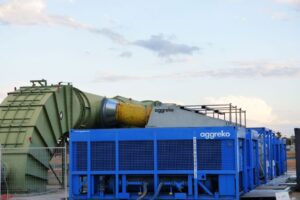This Guide provides practical guidance for a person conducting a business or undertaking (PCBU) on how to manage the risks associated with working in heat and information on what to do if a worker begins to suffer from a heat-related illness.
This Guide addresses heat that poses a direct risk to a worker’s health and safety, such as heat which may cause heat-related illness. For information on thermal comfort – that is, whether a worker is comfortable at a particular temperature – see the Code of Practice:
Managing the Work Environment and Facilities.
What are some common effects of working in heat?
Working in heat can be hazardous and can cause harm to workers. The human body needs to maintain a body temperature of approximately 37 degrees Celsius. If the body has to work too hard to keep cool or starts to overheat a worker begins to suffer from heat-related illness. This is a general term to describe a range of progressive heat related conditions including fainting, heat rash, heat cramps, heat exhaustion, and heat stroke.
Some other common effects of working in heat include:
- Heat rash. Skin can become irritated and cause discomfort when working in heat.
- Heat cramps. Muscles can cramp as a result of heavy sweating without replacing salt and electrolytes.
- Fainting. Can occur when workers stand or rise from a sitting position.
- Dehydration. Increased sweating can lead to dehydration if workers aren’t drinking enough water.
- Heat exhaustion. Occurs when the body is working too hard to stay cool.
- Heat stroke. Occurs when the body can no longer cool itself. This can be fatal.
- Burns. Can occur if a worker comes into contact with hot surfaces or tools.
- Slips. A worker will sweat more in hot conditions which can increase the risk of slips – for example, a worker might slip when using sharp tools if their hands are damp.
- Reduced concentration. When working in heat it is more difficult to concentrate and a worker may become confused. This means workers may be more likely to make mistakes, such as forgetting to guard machinery.
- Increased chemical uptake into the body. Heat can cause the body to absorb chemicals differently and can increase the side effects of some medications.
How can you manage risks?
The following steps should be used, so far as is reasonably practicable, to ensure that workers and other people are not exposed to harm from working in heat. More information on the risk management process is in the Code of Practice: How to manage work health and safety risks.
1. Identify the hazard
Heat is a hazard in many Australian workplaces, whether work is performed indoors or outdoors. To find out if it is a hazard in your workplace, consider:
- air temperature
- air flow
- humidity
- radiant heat sources
- work requirements, and
- the workplace itself
To help you identify hazards in your workplace you should talk to workers, including any health and safety representatives, and other duty holders. You can also talk to businesses similar to yours and find out whether heat is a hazard in that workplace, or to review near misses, incidents and injury records. This can help you identify risks in your workplace.
2. Assess the risk
A risk assessment can help you determine:
- how severe the risk is;
- whether existing control measures are effective;
- what action you should take to control the risk, and
- how urgently you need to take action.
To assess the risk you should consider:
- what is the impact of the hazard, and
- how likely is the hazard to cause harm.
- How hot a worker feels will be different in every situation, depending on the individual worker, the work they are doing and the environment in which they are working.
The work
- Where is the work being done? Working near heat sources (for example, hot plant or hot surfaces) or in the sun increases exposure to heat.
- Is the work physically demanding? How long will the worker be doing physically demanding work? Physical effort increases the risk of heat-related illness, even in moderate conditions.
- How long will the worker be exposed to heat? When and where can they take breaks?
- Extended exposure to heat makes it harder for the body to stay cool.
- Could anything prevent a worker from pacing their work? For example, pieceworkers or workers with performance-based salaries may not want to reduce their work rate in hot conditions.
- When is work being done? For example, working in a roof cavity or outside is most hazardous during the hottest parts of the day and year.
- Is the work complex or difficult? Concentration may be affected by heat.
The worker
- What is the worker’s capability? Are they trained, qualified and competent for the work they are doing? An apprentice may take longer to do a task or might not know how to work safely, and their supervisor might also be at increased risk if he or she is exposed
- to heat for a longer time. Is the worker physically fit and are they acclimatised to the current environment?
- Are workers required to wear clothing such as personal protective equipment (PPE), standard dress or a uniform? Clothing that impairs the evaporation of sweat increases the risk of heat-related illness.
- Keeping in mind your obligations under other legislation including privacy and
- discrimination laws, consider whether a worker has disclosed anything which indicates
- they are susceptible to heat-related illness. For example, is the worker:
- Taking certain medications such as diuretics, antidepressants or anticholinergics?
- Taking non-medical drugs such as ecstasy?
- Suffering from a condition such as diabetes, obesity, a skin disorder, febrile illness or heart disease?
A previous sufferer of heat-related illness?
Pregnant?
At risk of dehydration or electrolyte depletion for example they have diarrhoea, vomiting, or are on a fluid-restricted diet?
Younger (aged 25 or less) or older (aged 55 or more)?
Returning to work after an absence, such as a fly in fly out worker, or someone returning to work after an incident?
Note on acclimatisation
Acclimatisation means that the body is starting to adapt to heat. An acclimatised worker may begin to sweat more efficiently and can more easily maintain a normal body temperature. Remember, a person’s body can only adapt so much and this is not a reliable control. If you plan to introduce an acclimatisation program to manage the risks associated with working in heat in your business, consult a professional like an occupational hygienist. Workers who are not acclimatised, or are returning to work after an absence of a week or more, are at a higher risk of experiencing a heat-related illness.
The working environment
- What is the air temperature? Work being done outside or in a roof cavity will be hotter during the day and in summer.
- What is the radiant temperature? Radiant temperatures may be high when working in the sun such as on a concrete or metal roof, or near hot machinery or processes, such as in a furnace, kitchen or manufacturing workshop.
- Is there air movement or wind? Confined spaces or poorly ventilated spaces have
- minimal air movement making them hotter.
- Is it humid? Humidity makes it more difficult for a person to cool down.
- Is there access to cool drinking water? Dehydration can occur if a worker isn’t taking in
- enough water.
- Is the work space well ventilated or air-conditioned or are there air-conditioned break rooms?
- Are workers working alone? A worker may not be able to seek help in an emergency.
- Is there quick access to support services such as first aiders and emergency services?
- Heat-related illness can be fatal if left untreated.
- Is there an emergency plan? If a worker collapses in a confined space, for example, an emergency plan can help get them out and into treatment without delay.
- Can the worker get to and from work safely? Exposure while travelling can make workers more vulnerable to heat-related illness.
- Is there a heatwave? Hot days and nights can contribute to worker fatigue.
Note on useful resources
Workplace Health and Safety Queensland has published a Heat Stress basic calculator that may assist you in assessing the risk of working in the heat. The Bureau of Meteorology (BOM) is also a useful source of up to date information, particularly if your workers will be working outdoors or somewhere where environmental conditions can affect temperature and humidity. BOM’s Heatwave Service for Australia forecasts the location and severity of heatwaves and information on climate zones of Australia, which can help you identify the likelihood of high temperatures and high humidity.BOM also publishes a range of local forecasts and current observations. You can use simple indices such as apparent temperature, which is calculated using ambient temperature and relative humidity, to help you estimate how hot conditions feel to your workers.
Read more Mining Safety News and Resources.














Add Comment